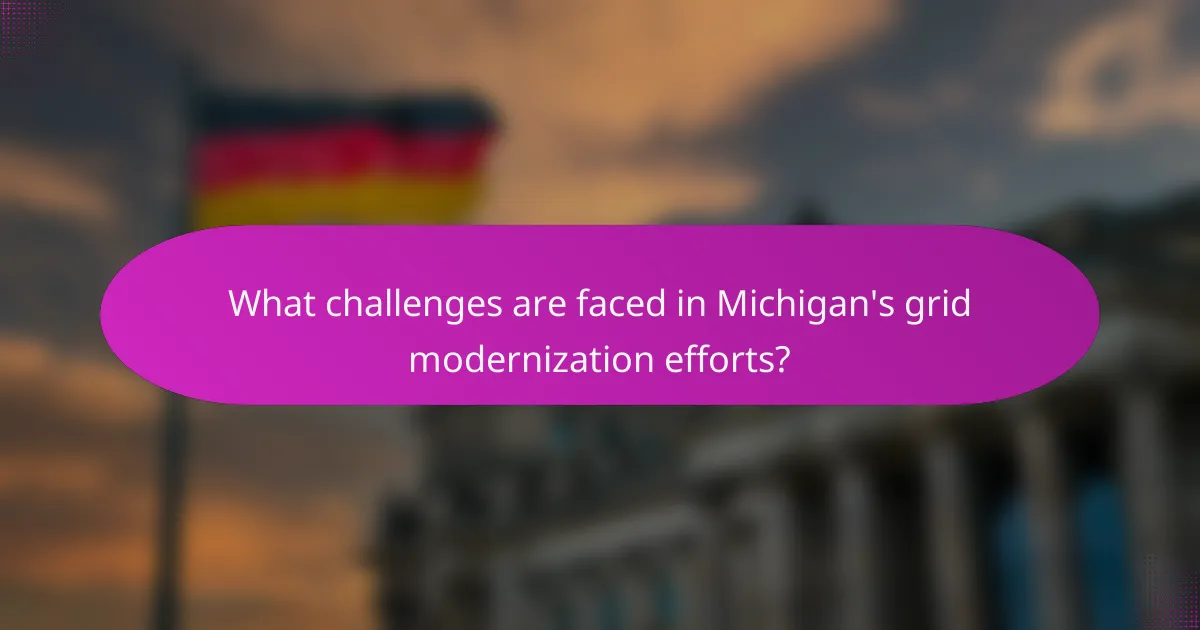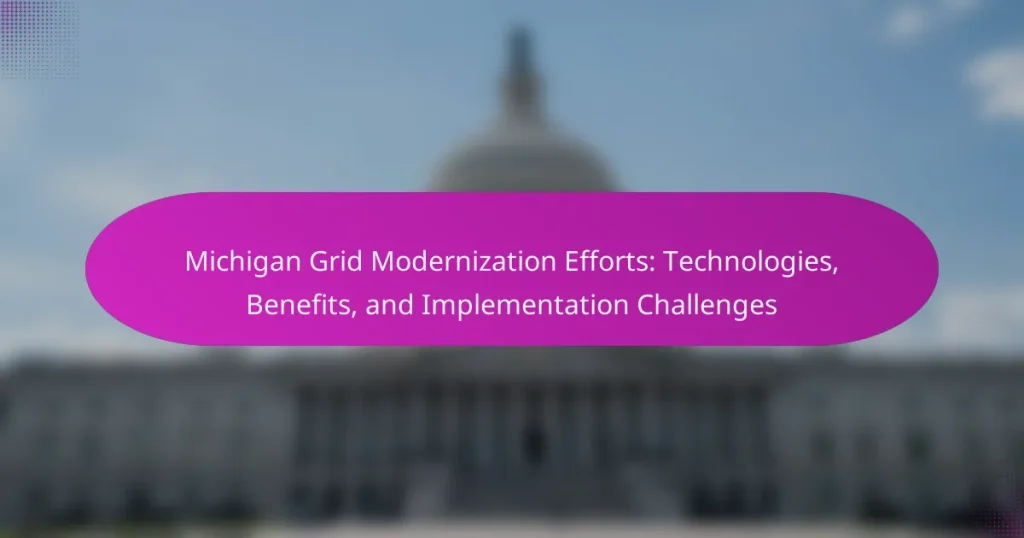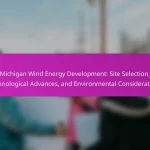
What are Michigan’s Grid Modernization Efforts?
Michigan’s grid modernization efforts focus on upgrading the electrical grid to enhance efficiency and reliability. These initiatives include the deployment of smart grid technologies. Smart meters are being installed across the state to provide real-time data on energy usage. This data helps in managing demand and reducing outages. Additionally, Michigan is investing in renewable energy sources. The aim is to integrate solar and wind power into the existing grid. These efforts are supported by state policies promoting clean energy. The Michigan Public Service Commission oversees these modernization projects. Overall, these initiatives are designed to create a more resilient and sustainable energy system.
How is the grid modernization process being implemented in Michigan?
The grid modernization process in Michigan is being implemented through several strategic initiatives. Utilities are investing in advanced technologies such as smart meters and automated distribution systems. These technologies enhance grid reliability and efficiency. Michigan’s Public Service Commission oversees the implementation efforts. They ensure compliance with state regulations and standards. Collaborative programs involve stakeholders, including local governments and communities. The state has allocated funding for research and development in grid technology. Michigan aims to integrate renewable energy sources into the grid. This modernization process is essential for meeting future energy demands and sustainability goals.
What technologies are being utilized in Michigan’s grid modernization?
Michigan’s grid modernization utilizes advanced technologies such as smart meters, energy storage systems, and automated distribution systems. Smart meters enable real-time monitoring of energy usage. Energy storage systems, like batteries, enhance grid reliability by storing excess energy. Automated distribution systems improve fault detection and response times. These technologies collectively enhance efficiency, reliability, and integration of renewable energy sources. The Michigan Public Service Commission supports these initiatives to modernize the grid for future demands.
What are the key milestones in Michigan’s grid modernization journey?
Key milestones in Michigan’s grid modernization journey include the implementation of the Smart Grid Investment Grant in 2009. This initiative provided funding to enhance grid infrastructure. In 2013, Michigan established the Michigan Public Service Commission’s (MPSC) Grid Modernization Collaborative. This group focused on developing strategies for improving grid reliability.
In 2017, the MPSC released a report outlining key recommendations for grid modernization. This report emphasized the importance of integrating renewable energy sources. The deployment of advanced metering infrastructure began in 2018, allowing for better energy management.
By 2020, several utilities in Michigan had begun pilot programs for energy storage solutions. These programs aimed to enhance grid flexibility and reliability. In 2021, the state updated its energy policy to further support modernization efforts. This policy included incentives for renewable energy and energy efficiency programs.
Overall, these milestones reflect Michigan’s commitment to modernizing its energy grid for improved reliability and sustainability.
What benefits does grid modernization bring to Michigan?
Grid modernization brings several benefits to Michigan. It enhances reliability by reducing outages and improving response times. Modernized grids facilitate integration of renewable energy sources, promoting sustainability. They also optimize energy efficiency, leading to cost savings for consumers. Additionally, grid modernization supports advanced technologies like smart meters and demand response systems. These technologies empower consumers to manage their energy use better. According to the U.S. Department of Energy, modernizing the grid could save Michigan residents approximately $1 billion annually. Overall, these benefits contribute to a more resilient and efficient energy system in Michigan.
How does grid modernization enhance energy efficiency in Michigan?
Grid modernization enhances energy efficiency in Michigan by integrating advanced technologies and improving infrastructure. It enables real-time monitoring and management of energy consumption. Smart meters and sensors allow for better demand response strategies. This leads to reduced energy waste and optimized energy use. Enhanced grid connectivity supports the incorporation of renewable energy sources. As a result, Michigan can decrease reliance on fossil fuels. According to the Michigan Public Service Commission, these advancements can lead to a 10-20% reduction in energy usage. Overall, grid modernization plays a critical role in promoting sustainable energy practices in the state.
What impact does grid modernization have on renewable energy integration?
Grid modernization significantly enhances renewable energy integration. It improves grid flexibility and reliability. Modernized grids use advanced technologies like smart meters and sensors. These technologies facilitate real-time monitoring and management of energy flows. Enhanced communication systems allow for better coordination between energy producers and consumers. This results in more efficient use of renewable resources. For instance, a study by the U.S. Department of Energy indicates that modern grids can accommodate up to 30% more renewable energy. This integration helps reduce reliance on fossil fuels and lowers greenhouse gas emissions. Overall, grid modernization is crucial for achieving sustainable energy goals.
How does grid modernization improve reliability and resilience of the grid?
Grid modernization enhances the reliability and resilience of the grid by integrating advanced technologies and improving infrastructure. These upgrades include smart meters, automated control systems, and enhanced communication networks. Smart meters provide real-time data, enabling quicker response to outages. Automated systems can isolate faults and reroute power, minimizing downtime. Improved communication allows for better coordination among utilities during emergencies. Additionally, grid modernization supports the integration of renewable energy sources, diversifying energy supply and reducing vulnerability to disruptions. According to the U.S. Department of Energy, investments in grid modernization can lead to a 30% reduction in outage durations. This combination of technologies and strategies strengthens the overall stability of the electrical grid.

What challenges are faced in Michigan’s grid modernization efforts?
Michigan’s grid modernization efforts face several challenges. Aging infrastructure is a primary issue, with many components needing upgrades. Regulatory hurdles complicate the implementation of new technologies. Funding constraints limit the scope of modernization projects. Additionally, stakeholder coordination is often inadequate, leading to delays. Public acceptance of new technologies can also be a barrier. Cybersecurity concerns pose risks to the reliability of modernized grids. Lastly, workforce shortages in skilled labor affect project timelines and execution.
What are the common obstacles encountered during implementation?
Common obstacles encountered during implementation include regulatory hurdles, funding limitations, and technological challenges. Regulatory hurdles can delay project approvals and complicate compliance. Funding limitations restrict the financial resources available for necessary upgrades. Technological challenges arise from integrating new systems with existing infrastructure. Stakeholder resistance can also impede progress, as various parties may have differing priorities. Additionally, workforce shortages may affect the availability of skilled labor for implementation tasks. These factors collectively hinder the timely and effective execution of grid modernization efforts in Michigan.
How do regulatory and policy issues affect grid modernization?
Regulatory and policy issues significantly impact grid modernization by shaping the framework for energy investments and technology adoption. These regulations dictate the standards for infrastructure upgrades and the integration of renewable energy sources. Policies can incentivize or hinder investment in smart grid technologies. For example, supportive policies may provide funding for innovative projects while restrictive regulations can delay implementation. The Michigan Public Service Commission’s regulations influence how utilities approach grid upgrades. In 2019, Michigan’s energy laws were revised to promote cleaner energy and modernize the grid, demonstrating the direct effect of policy on modernization efforts.
What financial challenges are associated with grid modernization in Michigan?
Grid modernization in Michigan faces significant financial challenges. These include high upfront capital costs for infrastructure upgrades. Estimates suggest that Michigan will require billions in investment to enhance its grid. Funding sources can be limited, leading to potential budget constraints. Additionally, there are ongoing operational costs associated with maintaining new technologies. Regulatory hurdles may also impede financial planning and investment. Stakeholder engagement is crucial, yet it can be resource-intensive and costly. Overall, these financial challenges can delay the implementation of necessary grid improvements.
How are stakeholders responding to these challenges?
Stakeholders are responding to challenges in Michigan’s grid modernization efforts by collaborating on innovative solutions. Utilities are investing in advanced technologies to enhance grid reliability. State agencies are developing policies to support sustainable energy practices. Community organizations are advocating for equitable access to energy resources. Research indicates that these collaborative efforts can lead to more resilient energy systems. According to a report from the Michigan Public Service Commission, stakeholder engagement is crucial for addressing implementation challenges effectively.
What role do utility companies play in overcoming these challenges?
Utility companies play a critical role in overcoming challenges related to grid modernization. They invest in advanced technologies to enhance grid reliability and efficiency. For instance, utility companies deploy smart meters and grid sensors. These tools provide real-time data on energy usage and system performance. They also facilitate quicker responses to outages and system failures. Furthermore, utility companies engage in stakeholder collaboration. This includes working with government agencies and local communities. Such partnerships help align modernization efforts with public needs. According to the Michigan Public Service Commission, these collaborations are essential for successful implementation. Overall, utility companies are pivotal in driving the transition to a modernized grid.
How are local governments and communities involved in the modernization process?
Local governments and communities play a crucial role in the modernization process of the Michigan grid. They participate in planning and decision-making for energy projects. This involvement ensures that local needs and concerns are addressed. Community engagement helps to build public support for modernization initiatives. Local governments often collaborate with utility companies to implement new technologies. They also provide feedback on proposed changes to infrastructure. This feedback is vital for tailoring solutions to specific community needs. Additionally, local governments may facilitate educational programs about energy efficiency. Their involvement fosters transparency and accountability in the modernization efforts.

What future trends can be expected in Michigan’s grid modernization?
Future trends in Michigan’s grid modernization include increased adoption of renewable energy sources, such as solar and wind. The state aims to achieve 50% renewable energy by 2030. Smart grid technologies will enhance grid reliability and efficiency. This includes advanced metering infrastructure and automated distribution systems. Energy storage solutions, like batteries, will support renewable integration. Electrification of transportation will drive demand for grid upgrades. Additionally, microgrid development will enhance resilience against outages. These trends align with Michigan’s commitment to sustainability and energy independence.
How will emerging technologies shape the future of Michigan’s grid?
Emerging technologies will significantly enhance the future of Michigan’s grid. These advancements include smart grid technology, which improves energy management and efficiency. Smart meters will enable real-time data collection and monitoring. This allows for better demand response and energy distribution. Renewable energy integration will be facilitated by advancements in battery storage solutions. These batteries can store excess energy generated from solar and wind sources. Additionally, artificial intelligence will optimize grid operations and maintenance. AI can predict outages and streamline resource allocation. Overall, these technologies will lead to a more resilient and sustainable energy infrastructure in Michigan.
What advancements in smart grid technology are anticipated?
Anticipated advancements in smart grid technology include improved energy management systems and enhanced grid resilience. These advancements will enable better integration of renewable energy sources. Additionally, advancements in communication technologies will facilitate real-time data sharing. Smart meters will provide consumers with detailed energy usage information. Enhanced cybersecurity measures will protect grid infrastructure from threats. Artificial intelligence will optimize energy distribution and consumption. These developments aim to create a more efficient and sustainable energy ecosystem. According to the U.S. Department of Energy, smart grid technologies can reduce energy costs by up to 10%.
How might consumer behavior influence grid modernization strategies?
Consumer behavior significantly influences grid modernization strategies by dictating energy demand patterns and preferences. As consumers increasingly prioritize renewable energy sources, utilities must adapt their grid strategies to incorporate more sustainable options. The rise in consumer interest for smart technologies, such as home energy management systems, drives investments in grid upgrades that enhance efficiency and reliability. Additionally, consumer engagement in energy-saving programs can lead to reduced peak demand, prompting utilities to modernize their infrastructure accordingly. Research shows that states with higher consumer participation in energy programs can achieve more effective grid management and lower operational costs. This correlation between consumer behavior and grid modernization is evident in various case studies, highlighting the need for utilities to align their strategies with consumer expectations.
What best practices can be adopted for successful grid modernization?
Successful grid modernization can be achieved through several best practices. First, investing in advanced technologies is crucial. This includes smart meters, sensors, and energy management systems. These technologies enhance monitoring and control of the grid. Second, engaging stakeholders is essential. Utilities should collaborate with government agencies, businesses, and consumers. This collaboration fosters transparency and builds trust. Third, implementing robust cybersecurity measures is necessary. Protecting grid infrastructure from cyber threats ensures reliability and safety. Fourth, adopting a phased approach to upgrades helps manage costs and minimize disruptions. Gradual implementation allows for adjustments based on feedback. Lastly, continuous training and development for workforce skills are vital. A knowledgeable workforce can effectively manage and operate modernized grids. These best practices collectively contribute to the successful modernization of the grid.
What lessons have been learned from other states’ grid modernization efforts?
States that have undergone grid modernization have revealed several key lessons. First, stakeholder engagement is crucial for successful implementation. States like California have shown that involving local communities fosters support and addresses concerns early. Second, investment in technology is essential. For instance, New York’s Smart Grid initiative demonstrated that advanced metering infrastructure enhances efficiency and reliability. Third, regulatory frameworks need to adapt. Massachusetts adjusted its policies to encourage innovation and competition in energy markets. Fourth, data management is vital. Illinois’ efforts highlighted the importance of real-time data for grid management and decision-making. Lastly, resilience planning is necessary. Hurricane recovery in Florida emphasized the need for infrastructure capable of withstanding extreme weather events. These lessons collectively underscore the importance of collaboration, technology, adaptability, data utilization, and resilience in grid modernization efforts.
How can public engagement enhance the grid modernization process?
Public engagement can enhance the grid modernization process by fostering collaboration and transparency. Engaging the public allows stakeholders to voice their concerns and preferences. This feedback can guide energy providers in making informed decisions. Additionally, public involvement increases trust in the modernization efforts. Studies show that communities with active engagement experience smoother implementation of new technologies. For instance, the Michigan Public Service Commission emphasizes stakeholder input in their grid initiatives. This approach leads to more tailored solutions that meet local needs. Ultimately, public engagement can drive greater acceptance and support for grid modernization projects.
Michigan’s grid modernization efforts focus on upgrading the electrical grid to improve efficiency and reliability through the implementation of smart grid technologies, including smart meters and energy storage systems. These initiatives aim to integrate renewable energy sources, such as solar and wind, while enhancing grid resilience and reducing outages. The Michigan Public Service Commission oversees these projects, addressing challenges such as aging infrastructure, regulatory hurdles, and funding constraints. Key milestones include the establishment of collaborative programs and the advancement of policies supporting clean energy. Overall, these modernization efforts are designed to create a more sustainable and efficient energy system in Michigan.


